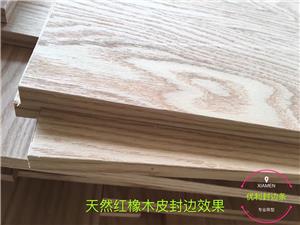News
-
02-14 2025
PVC edge banding and solid wood edge banding each have their unique advantages and disadvantages
PVC edge banding advantage: 1. Diverse appearance: PVC edge banding can imitate various materials, such as wood grain, marble, cloth grain, etc., with rich visual effects. 2. Lightweight: Compared to solid wood edge banding, PVC edge banding is lighter and easier to process and install. 3. Wear resistance: PVC material has good wear resistance and can resist scratches during daily use. 4. Waterproof and moisture-proof: PVC edge banding can effectively prevent moisture infiltration and is suitable for humid environments. 5. High cost-effectiveness: PVC edge banding is relatively affordable and an economical choice. 6. High production efficiency: Modern furniture production equipment is abundant, and modular furniture is easy to handle. Disadvantages: 1. Unstable quality: The quality of PVC edge banding on the market varies greatly, and some products may be prone to aging and breakage. 2. Obvious color difference: After trimming, there may be color difference in the PVC edge banding, which affects the appearance. 3. Poor high temperature resistance: PVC edge banding is prone to deformation in high temperature environments. Solid wood edge banding advantage: 1. Natural texture: Solid wood edge banding has the texture and texture of natural wood, beautiful and natural. 2. Strong environmental friendliness: Solid wood edge banding has superior environmental performance and does not contain harmful substances. 3. Soft and not easily deformed: Solid wood edge banding is soft and not easily deformed, and has good adhesion to furniture boards after bonding. Disadvantages: 1. Weak moisture resistance: Solid wood edge banding has poor moisture resistance and is prone to deformation or cracking due to moisture. 2. Expensive price: The production cost of solid wood edge banding is relatively high, and the price is relatively expensive. 3. High processing difficulty: A high level of craftsmanship is required during the processing of solid wood edge banding to ensure the edge banding effect. In summary, PVC edge banding and solid wood edge banding each have their own advantages and disadvantages. When choosing, comprehensive consideration can be given to factors such as the furniture's usage environment, personal aesthetics, and budget.
-
01-17 2025
The relationship between edge banding and hot melt adhesive
Hot melt adhesive is increasingly used in furniture edge sealing, but there are also many difficulties encountered during use. Below is a specific analysis of the common problems of adhesive bonding with hot melt adhesive for edge sealing: 1、 Edge sealing detachment: Check whether the operation is correct, operate according to the machine operation requirements and the correct parameters of hot melt adhesive; Check if the edge banding machine is functioning properly; Is the back coating of the edge banding normal? If it is a wooden edge banding, check whether it is a multi fat tree species or whether the moisture of the non-woven fabric on the back is qualified; Is the hot melt type suitable; Is there any quality issue with the hot melt solution. 2、 Insufficient edge sealing strength: whether the type of hot melt adhesive used is appropriate; Is the board too fluffy or unqualified, and is the stacking time of the board too long causing too much dust at the ports; Whether the edge banding is contaminated; Whether the back coating of the edge banding is uniform; The temperature of the hot melt adhesive is incorrect, the pressure of the edge banding machine is insufficient, and the operating pressure of the manual edge banding machine relies on manual control, which is particularly prone to the above problems; The operating environment temperature is too low. 3、 Thick glue line: The model used is incorrect. For example, fast glue is used on a slow machine and is not bonded, while hot melt glue has already started to solidify, resulting in loose compression; The precision of sheet metal processing is insufficient, the sawing is not good, and the cutting edge is not straight enough; The edge banding is deformed and not horizontal or curved enough; The pressure wheel of the edge banding machine is worn, and the pressure is uneven up and down, resulting in thick adhesive lines on one side; The pressure of the edge banding machine is insufficient and cannot be tightened. A pressure of 3-5kg/cm2 is required; The amount of glue applied is too large, causing glue to overflow. 4、 Wire drawing contaminated sheet: Poor quality of hot melt adhesive; Improper selection of models, such as using slow glue on high-speed machines, prolonged opening time of hot melt adhesive, and slow drying of glue; The temperature of the hot melt adhesive is too high, or the speed of the edge banding machine is too fast; The amount of glue applied is too large; The quality of the glue roller is poor, and it cannot be evenly coated or adjusted reasonably. 5、 After spraying the paint for a few days after edge sealing, it falls off: the edge sealing has not reached high bonding strength. Check whether the operation is reasonable or whether the quality of the hot melt adhesive is qualified; Spray paint peeling off the wooden veneer, check if there is too much grease on the back of the veneer or if the non-woven fabric (paper) on the back is too wet; Spray paint peeling off the wooden veneer, check whether the pores of the veneer are too large, and whether the solvent of the paint penetrates into the adhesive and damages the adhesive film; The quality of hot melt adhesive does not meet the requirements, and low-temperature adhesive is not suitable for use in such processes; Poor handling during edge sealing results in thick adhesive lines, leading to poor sealing and solvent penetration into the adhesive film, which can damage its strength.


